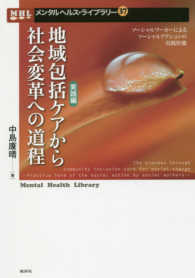Full Description
This classic text has been helping teachers better understand young children's behaviour for over 6 decades. Now available in an updated seventh edition, this popular resource is designed to deepen pre- and inservice teachers' understanding of children (birth-age 8) as unique individuals within a developmental context. Observation notes recorded over time reveal patterns in children's behaviour, as well as ways in which behaviours may change. To strengthen teachers' efforts to better understand children as individuals, the authors provide a timeless methodology for documenting young children's behaviour as they actively engage in classroom life. They outline methods for recordkeeping that capture children's interactions and experiences in the classroom. Numerous examples of teachers' observations of children enrich this work and make it accessible, practical, and enjoyable to read.
Book Features:
Provides early childhood educators with a guide for observing and recording as a way of better understanding children, while holding judgment in abeyance.
Examines the need for teachers to reflect on their own experiences, even as children, and how these may influence their reactions to children's interactions and behaviours.
Focuses on the centrality of family, community, and culture in children's lives, reflecting the diversity in contemporary early childhood classrooms.
Explains the imperative for teachers to observe and record the behaviour of young children as a means of interpreting their developmental capacities and abilities.
Contents
Preface to the Seventh Edition
1. Getting Started
Why Records
Keeping records
Language as a Tool in Recording
Importance of the Environment
2. Recording a Child's Behavior During Routines
Organizing the Information
The Meaning of Routines to Young Children
Recording Eating Behavior
Recording Toileting Behavior
Recording Behavior at Rest Time
Recording Behavior During Transitions
Patterns of Behavior During Routines
3. Recording a Child's Use of Materials
A Note on Technology
The Meaning of Materials to Young Children
What to Observe
Records of Use of Materials
How the Child Does What
Records Illustrating Detail
Interpratation: the Last Dimension
Patterns of Behavior in Use of Materials
4. Recording Children's Behavior With One Another
How Children Learn to Socialize
Do We Really See What Is Going On?
What to Observe
Patterns of Behavior in Children's Response to Other Children
Group Membership
5. Recording Children's Behavior in Dramatic Play
Capacity for Symbolic Representation
A Framework for Recording Dramatic Play
Focusing on Dramatic Roles
Social Aspects of Dramatic Play
Patterns of Behavior During Dramatic Play
6. Recording the Child's Relationships With Adults and in Adult-Directed Activities
Teachers Observe Themselves
Recording a Child's Interactions With an Adult
Gaining Information About a Child's Larger Social World
Recording a Child in Teacher-Directed Group Activities
Patterns of Behavior in Children's Relationships With Adults
7. Clues to Cognitive Functioning
How Do Children Learn?
Developmental Approach to Thinking in Early Childhood
How Can We Know a Child's Approach to Thinking?
8. Clues to Cognitive Functioning
Temperament of a Child
The Influence of Culture and Social Experience
How Do We Know What Children Are Thinking About and Learning?
How Can Children Discover What Children Know?
9. Observing Children Develop the Power to Think
Forming Generalizations
Ability to Differentiate
Ability to Perceive Similarities and Differences
Ability to Draw Analogies
Ability to Perceive Cause and Effect
Time Orientation
Ability to Seriate and Classify
Perceiving Patterns
Understanding Spatial Relationships
10. Recording Children's Developing Language and Emerging Literacy
Language and Culture
Recording Children's Use of Language
Observing Speech
Observing Emergent Literacy
11. Recording Behaviors That Are Disquieting
Value of Gathering Information
Examples of Unusual Behavior
12. Observing and Recording the Behaviors of Infants and Toddlers
Making Sense of What You See
The Value of Recording
The Influence of Time of Day
What to Observe
13. Patterns
Patterns
Features of the Final Summary
Interpretation
Final Summary
References
Index
About the Authors








